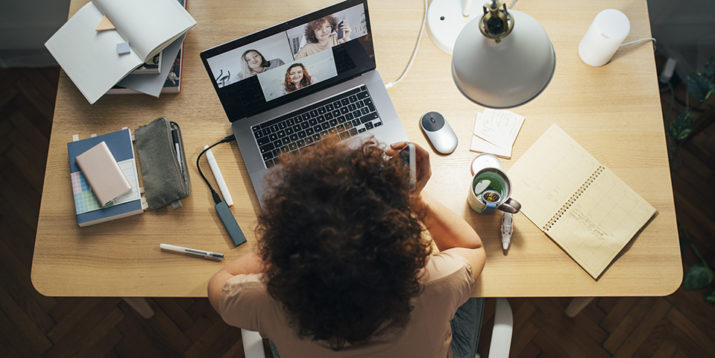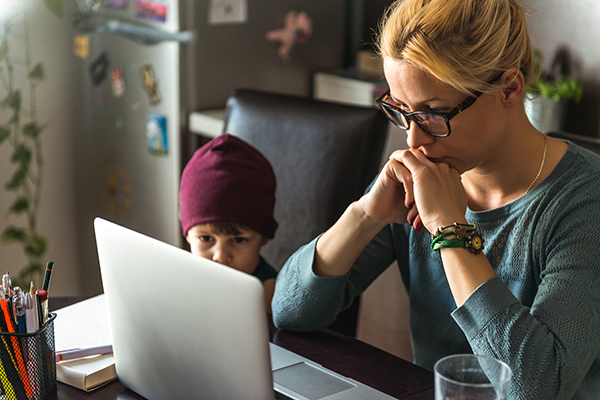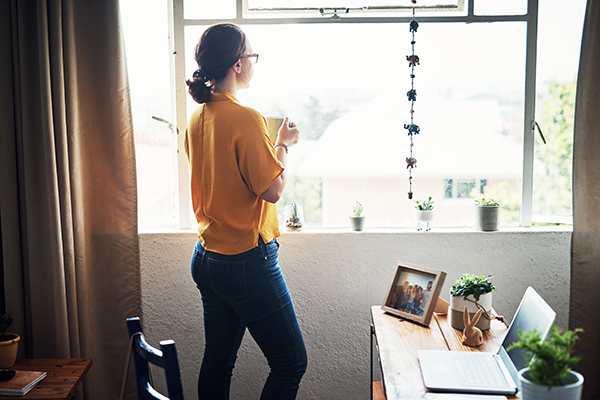Tips to Combat Zoom Fatigue

If you cringe a little bit when a Zoom invite pops up in your inbox, you’re not the only one.
Around 40 percent of people in the U.S. are working from home right now, and that means we’re spending a lot of time on Zoom conference calls.
Add in Zoom birthday parties, Zoom workouts, Zoom happy hours, and Zoom weddings, and it’s no wonder many of us are experiencing “Zoom fatigue.”
What Is Zoom Fatigue?
Zoom fatigue, or zoom exhaustion, is the physical and mental fatigue associated with attending virtual meetings.
There’s no denying that virtual conference platforms have been an invaluable tool this year. And there are certain aspects we love: You only have to get dressed from the waist up for work meetings.
You can attend happy hours from the comfort of your couch. You can celebrate momentous occasions while staying socially distant.
But there’s a downside to all this convenience. Communication is more challenging over a video chat, and the extra effort required can zap your energy.
And being hunched over a computer screen all day is tiring in its own way.
So after a long day of virtual meetings, you may feel noticeably more exhausted than you would on a normal workday.

Why Are Virtual Meetings Mentally Draining?
During in-person meetings, nonverbal communication plays an important role.
You might use body language to gauge your boss’s reaction as you’re presenting an idea or share an eye roll with a colleague across the table.
“When we meet face-to-face, we can unconsciously process messages — such as body language, or the energy that the participants emit,” says Nikola Djordjevic, M.D., a board-certified family physician and medical advisor at Whatasleep.
But Zoom meetings “strip you from all those cues,” Djordjevic says. “They require a hard focus to listen to the voices, read only the faces, and simultaneously process the chat messages or shared documents. All these efforts lead to fatigue.”
Add in the stress of Wi-Fi issues, anxiety over household distractions, and the awkwardness of staring at your own face all day, and you’ve got a recipe for mental exhaustion.

The Physical Effects of Zoom Fatigue
Too many virtual meetings may also make you feel physically tired.
When you’re sitting still for an extended period of time, your hips and knees are fixed in a 90-degree position, explains Theresa Marko, P.T., D.P.T., M.S., O.C.S., board-certified orthopedic clinical specialist in physical therapy and owner of Marko Physical Therapy, PLLC.
“This causes your hip flexors and hamstrings to get very tight since they are in a shortened position,” Marko adds. So you may feel some stiffness when you eventually get up and walk around.
Your neck, head, and arms are also in a static position while you’re staring at the screen.
You’re not turning to hear what a colleague across the room is saying, or changing position to view a presentation. This may cause the muscles that support your posture to fatigue and feel tighter, Marko says.

How to Prevent Zoom Fatigue
Virtual meetings may not be going away any time soon, but you can put these tips and techniques into practice to help mitigate the potential for Zoom fatigue.
During the meeting…
Check your ergonomics
“Make sure your monitor is at eye level and your chair height is positioned so both feet touch the floor,” says Keith McWilliams, an occupational therapist and instructor at the University of St. Augustine for Health Sciences’ Dallas campus.
Adjust your keyboard so your shoulders are relaxed, elbows are bent, and wrists are in a neutral position, he adds.
Stop staring at your face
Constantly double-checking our appearance adds unnecessary anxiety. On Zoom, consider hiding your own view of yourself by right-clicking your video and selecting “Hide Myself.” (Your colleagues will still be able to see you.)
Avoid harsh lighting
Avoid bright lights near windows which may cause excessive glare, and low lights in interior rooms that may cause strain on the eyes,” McWilliams says.
Play around with your screen’s contrast until you can see clearly without straining your eyes.
Avoid multitasking
“The temptation to check your email while someone is speaking may be high, but multitasking during Zoom calls can add on to your mental fatigue and Zoom exhaustion,” says Brian Wind, Ph.D., a clinical psychologist and Chief Clinical Officer at JourneyPure.
Between Meetings…
Build in buffers
If possible, schedule a short break between meetings — then utilize that time to give your body and mind a break.
“Give yourself some time to walk around, stretch, or look at something else for a while besides a computer screen,” Wind says.
You can even squeeze in a 10-minute meditation so you’re refreshed and ready for the next meeting.
Stretch
Between meetings, it’s important to get up and stretch the hamstrings and hip flexors, Marko says. (Try these 9 simple stretches you can do at your desk.)
Marko also recommends using a short foam roller to loosen tight neck and back muscles.
Follow the 20-20-20 rule
Staring at a screen all day is guaranteed to tire out your eyes. To avoid eye strain, McWilliams says, “Every 20 minutes, give your eyes a 20-second break by focusing on something at least 20 feet away.”
Skip the video
Not every meeting and social interaction has to be done via video! Sometimes, when you’re feeling Zoomed out, a good old-fashioned phone call might just do the trick.
